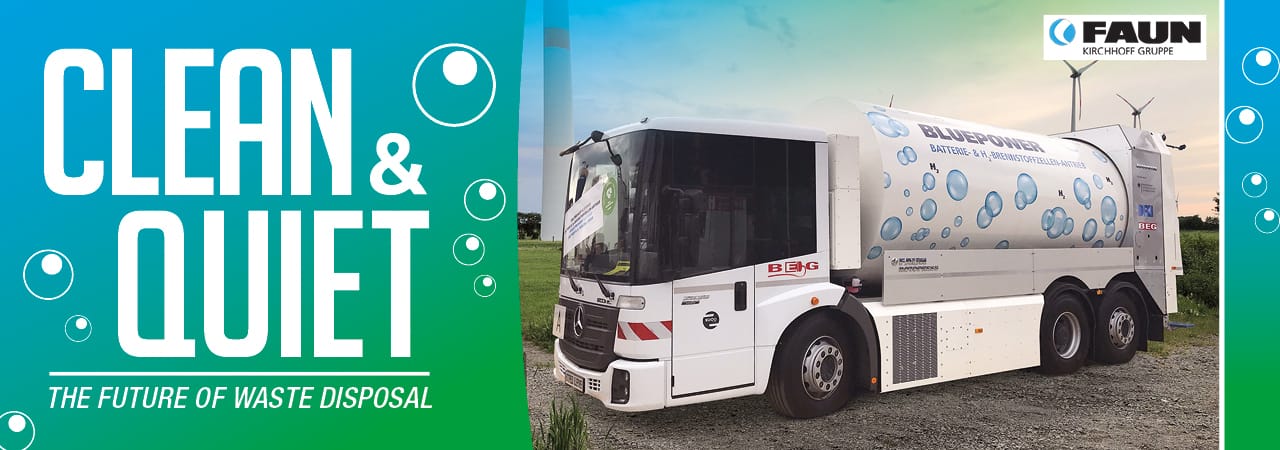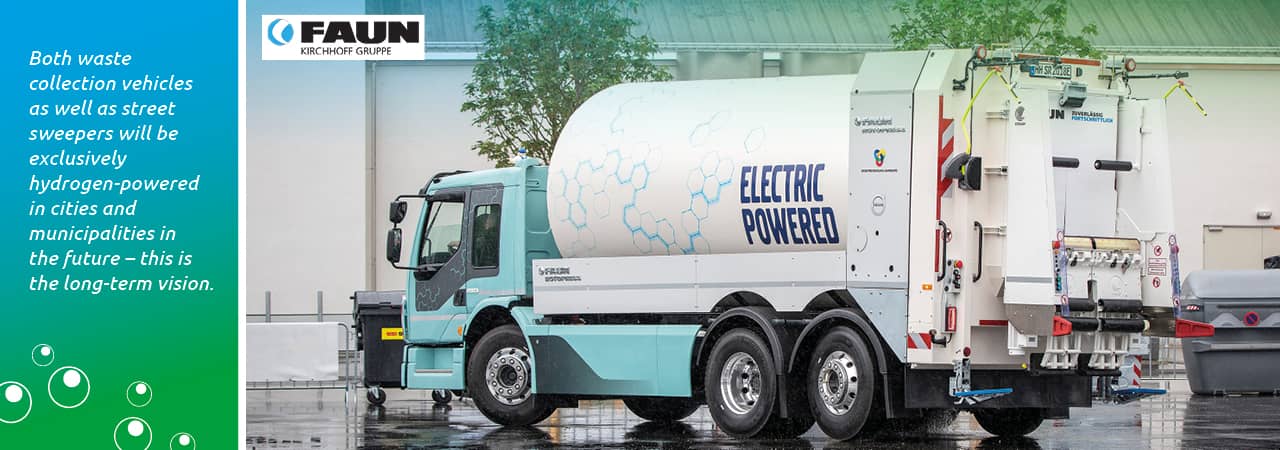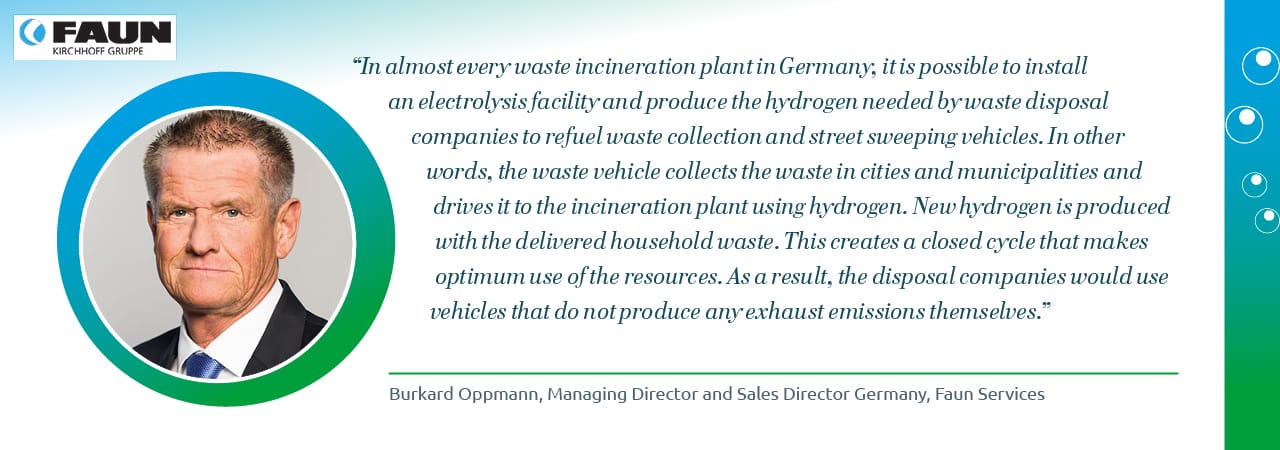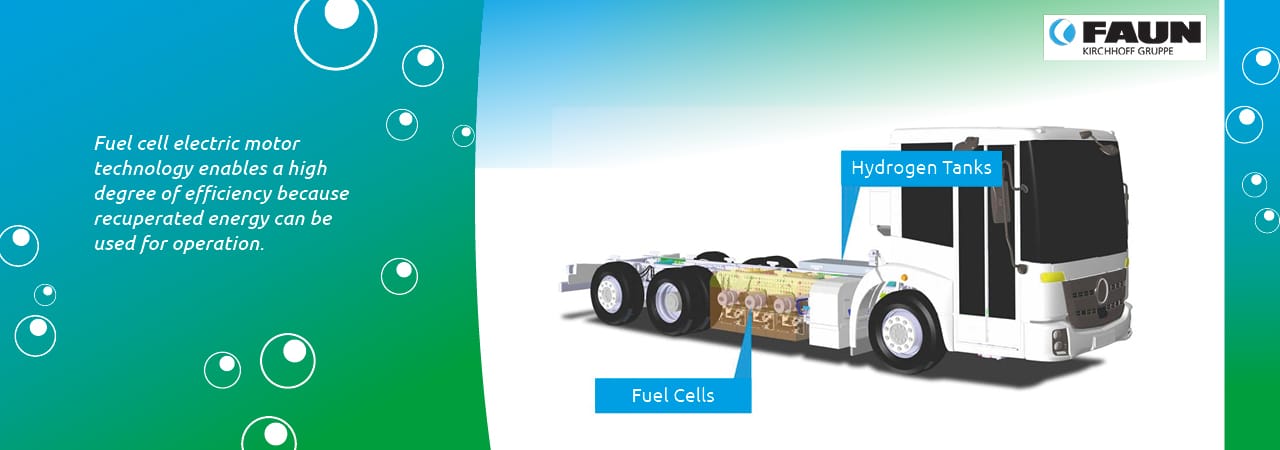Clean and quiet: the future of waste disposal!
In 2018, Faun, the manufacturer of waste disposal vehicles caused a sensation with the world premiere of newly-developed 'Bluepower' electro-hydrogen fuel cell powered waste collection vehicles.
The first vehicles are to be quietly put into regular operation in German cities starting in 2020. According to its own statement, the globally active company is currently the only supplier of this propulsion technology and a market leader in the field of waste disposal and street sweepers in Europe.
Burkard Oppmann, Managing Director and Head of Sales Germany, Faun Services spoke with RFID & Wireless IoT Global about how Faun intends to use this initial situation to contribute to the reduction of emissions.
Through the targeted use of sensor technology, Faun also intends to contribute to the implementation of smart city solutions in the sectors of waste disposal and city cleaning.
Propulsion with Hydrogen Fuel Cells
Beginning in 2020, the first Faun waste collection vehicles with electric hydrogen fuel cells will be on display in German cities. Hydrogen burns emission-free and is therefore one of the most important alternative fuels of the future. Using it as a fuel for waste disposal makes particular sense because it can be produced by electrolysis in waste incineration plants. The fact that the hydrogen refueling station network is so sparse means that there is no obstacle in its acquisition.
According to Burkard Oppmann, Managing Director and Head of Sales Germany, Faun Services: “The majority of customers who buy or will buy such a vehicle intend to guarantee their own production of hydrogen. The cost per liter is roughly comparable to a liter of diesel.”
Waste Collection Vehicles with Bluepower
Although Faun is mainly known for waste disposal superstructures on truck bodies, it has been successfully testing and using alternative propulsion systems since the early 2000s. A waste collection vehicle with diesel hydrogen propulsion was used in a pilot project at Berlin City Cleaning (Berliner Stadtreinigung (BSR)) between 2011 and 2013. ‘Bluepower’ is the evolution of that.
Two prototypes, a waste collector and a street sweeper, were presented for the first time at the IFAT in Munich in 2018 and were awarded first place with the VAK Innovation Award.
The development partner Daimler-Benz supplies the frame of the truck model Econic without an engine, a transmission or a propulsion train. The electric motor is installed in a modular system and supplemented by up to three fuel cells, depending on the customer’s requirements. The electric batteries have an output of 85 kilowatt hours and consist of 48 modules, each weighing 20 kilograms. Fuel cells with an output of 30, 60 or 90 kilowatt hours are then used in addition to the total of 960 kilowatt batteries.
Six or eight tanks are required, each with a capacity of 4 kilograms of hydrogen. The combination of battery and fuel cell serves to increase the range. A Bluepower-powered waste collection vehicle thereby has a maximum range of up to 650 km. That said, the vehicle would have to be refueled every two to two and a half days.
Costs Individually Tailored for the Benefit
The superstructures, batteries and hydrogen tanks have the same weight as a waste collection vehicle equipped with a conventional engine, which means that the payload is the same as that of other Faun waste collectors.
“The new generation of waste collectors will be used by municipalities that want clean technology that meets their specific needs. This is guaranteed by the fact that data collection vehicles travel to the respective collection area beforehand in order to determine the required range of a waste collector and the capacity utilization of the containers. The configuration of the required vehicle is then determined for a specific case and the vehicle is equipped accordingly: sometimes with more, sometimes with fewer fuel cells. The acquisition costs of a Bluepower waste collection vehicle for customers are therefore variable but will be 3.5 times as high as those of a classic waste collection vehicle,” explains Burkard Oppmann.
The managing director of Faun Services is confident that the future will bring a favorable price trend as hydrogen propulsion continues to develop.
100% Emission-Free
According to the manufacturer, Faun’s Bluepower technology enables a 100 percent electric emissionfree propulsion system. Noise generation is marginal. Once a Bluepower-powered vehicle has set itself into motion via battery propulsion, the fuel cells take over. Energy from hydrogen is used not only to power the main propulsion, but also to power brushes and vacuum cleaners in street sweepers.
The energy generated during braking is fed back into the system and can be retrieved during subsequent operations.
“As soon as Bluepower waste collection vehicles are produced in larger quantities over the next few years, the approximate 6,000 disposal vehicles that do not meet the Euro 6 emissions standard and are currently still in operation throughout Germany can gradually be replaced. The resilience of the Bluepower technology is impressive – the fuel cells are almost indestructible”, says Burkard Oppmann.
Batteries, on the other hand, will decline after eight years of 100 percent power consumption. In total, the company expects a service life of ten to twelve years, which corresponds to that of a conventional waste collector. Bluepower waste collection vehicles have been ordered by a number of cities so far. Faun expects an annual output of up to 300 vehicles with this technology by the end of 2024.
Benefits for the City
At present, both politicians and municipal donors are concentrating almost exclusively on e-mobility. According to Burkard Oppman, this creates a number of infrastructural challenges: "The power grid in Germany has not yet been configured to charge a large number of municipal electric vehicles.”
In order to guarantee the security of supply at electric refueling stations, a high level of infrastructural expenditure would be necessary to simply lay power lines along the roads.” According to Burkard Oppmann, it would be much more efficient in every respect to further develop and promote hydrogen- based propulsion technologies. Some funding programs already exist, others are in the planning stage.
“However, there is currently a standstill”, says Oppmann, “because extensive subsidies in the fuel cell sector are still being cut back unused, since we and others cannot move technology forward so quickly to be able to use these subsidies within the specified time frame. However, there is a lot of interest in Bluepower propulsion systems as well as inquiries from major European cities and from sectors other than waste management".
Sensors for Smart City Solutions
Having started 100 years ago as an automobile manufacturer, FAUN has taken a decisive step towards digitalization with its subsidiary KOCO Solutions.
With intelligent electronics, KOCO provides reliable operating data from the waste collection vehicle. Based on the data, the expected utilization of a waste collection vehicle is also calculated on the basis of actual tours, forecast data and level indicators in collection containers and serves as the foundation for determining the energy requirement.
KOCO also provides the workshop with diagnostic data on the superstructure and lift, enabling it to view online occurrences, error codes and maintenance needs at any time without having to coordinate with the driver. By avoiding consequential damage, e.g. forgetting to refill oil in the central lubrication system, the energy efficiency of the waste collection vehicles is well-maintained.
At the same time, maintenance can be planned more efficiently so that unplanned vehicle breakdowns are avoided. Automated reporting with data on actual waste quantities per unit of space also means that municipalities can plan the areas in which their disposal vehicles are used more flexibly and cost-effectively.
Recuperative Brakes
When collecting household waste, a disposal vehicle makes multiple stops. This can be every few meters in densely populated areas. During a ‘normal’ braking process, the kinetic energy previously used is lost at each stop.
Since the beginning of the 20th century, there have been considerations about how this energy could be recovered. Recuperative braking has been used in rail vehicles for a long time. Some types of alternating voltage locomotives and railcars transmit the kinetic energy back to the transformer via complex circuits and then feed it into the overhead line.
“In the case of electric motors in passenger cars, the recuperation process is comparable, with the exception that storage here is via accumulators or flywheels. In this way, a large part of the braking energy can be used again for acceleration. Faun waste collection vehicles thus require up to 40 percent less energy and the exhaust gases are free of carbon dioxide and nitrogen oxide. Since electric propulsion can also be used to brake the vehicles, fine dust emissions are considerably reduced compared to conventional braking systems,” explains Burkard Oppmann.
Join Matthias Siegel, Managing Director, KOCO solutions GmbH, a part of Faun Services at the RFID & Wireless IoT tomorrow 2019 on Oct 29th & 30th in Darmstadt, just outside Frankfurt, Germany in the automotive forum: Hydrogen Drive and Smart Sensors for Sustainable Use in Cities: Faun is Building the Future of Waste Collection Trucks.







